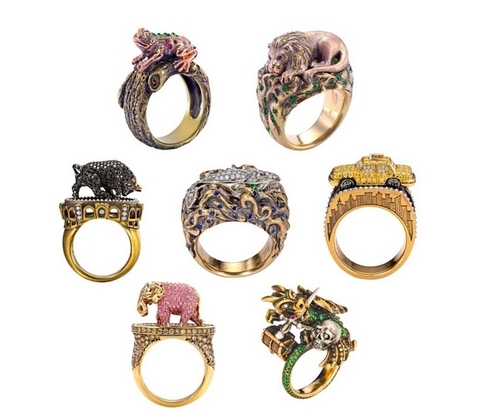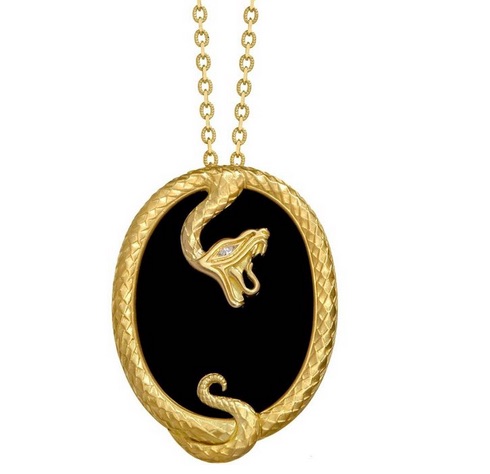General Specific: Now is not the time to discuss this, Mad Scientist.
Angry Scientist: First of all, I am not mad! I am angry! I am an angry scientist! That is what it is saying on my card of businesses!Sheep in the Big City
“To Bleat or Not to Bleat,” Season 1, Episode 2
Nov. 24, 2000
My unpopular opinion about last Sunday’s penultimate episode of Game of Thrones: Daenerys is not a “Mad Queen.” She’s an angry queen! In fact, that is what it is saying on her new card of businesses, under “Queen Daenerys Stormborn of the House Targaryen, the First of Her Name, Queen of the Andals, the Rhoynar and the First Men, Lady of the Seven Kingdoms and Protector of the Realm, Lady of Dragonstone, Queen of Meereen, Khaleesi of the Great Grass Sea, the Unburnt, Breaker of Chains and Mother of Dragons.”
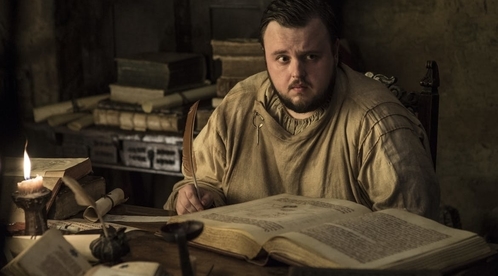
Samwell Tarly looks like he’s reading a book, but it’s merely Daenerys’s business card.
Sentimentally, I would love to see a wise, merciful, and just female victor ascend to the Iron Throne, though the name of the throne indicates how unlikely that is. As a storyteller, I think that, at the very least, Daenerys could have been a better anti-hero or villain if Game of Thrones show runners David Benioff and Dan Weiss gave even a single fuck about things like character development and common sense. Then they might have taken HBO up on its willingness to give the show more time to reach a resolution, so they didn’t shatter viewers’ belief in characters — both loved and loathed — in order to meet a self-imposed deadline. Perhaps D&D’s deal to do the next Star Wars movie was more enticing: Think of the money they’ll make while hoping people get over the nausea induced by Confederate, the slavery fanfic they convinced HBO to proudly announce in 2017. But, no, David and Dan are like:
Fortunately, I’m qualified to ease your GoT disappointment a tiny bit. The fictional world of Game of Thrones, originally created by author George R.R. Martin, has obvious differences from ours, including, but not limited to, dragons, magic, annoying warging boys, and unpredictable years-long seasons (the latter might be about to change here. But other elements come right from history.
As a jewelry designer whose art is influenced by real-life historical women — often royal women — I’ve spent years reading about the absolute monarchs and other authoritarians who did (and will) rule by fear, not love, as Dany has abruptly accepted on Game of Thrones. I didn’t create a fierce dragon ring and earrings, followed by a seven-piece collection named “Maneater,” because the main inspiration, China’s 7th-century Empress Wu, was a pushover. Wu wouldn’t have made history if she hadn’t been ready, willing, and able to kill hundreds or thousands of people … and her own family as a bonus.
Please keep in mind that inspiration doesn’t equal endorsement. In real life, I treasure the 20th-21st Century ideals of human rights and democracy. As the United States slides into authoritarianism, in the thrall of precisely the kind of demagogue feared by the framers of our Constitution, I value more than ever the humane treatment of all people and the improved governance that requires, and I am doing everything I can to contribute to the effort to create that world. If I could ask Bran Stark to deliver a message for me during his often-destructive time-traveling, I’d direct him to the many older and supposedly wiser people who told me for so long that “everyone becomes a Republican; just wait till your my age.” He can tell them:
Let’s hope Bran won’t mentally destroy anyone in the process.
I would never have become as fascinated by ruthless women — and as knowledgeable about the multitudes of ruthless men they dealt with — if male historians and novelists from ancient to modern days hadn’t portrayed powerful women as uniquely murderous, even by the standards of their time and cultures. That bothers me. I see the women as being, let’s say, as pragmatically murderous as male rulers. It’s not for nothing that Empress Wu called herself by the male title of “emperor” during her reign; she was just one of the boys. Maybe she had heard good things about Emperor Yang-Ti of the Sui dynasty, who took the throne in the year 604 — 20 years before Wu was born — after assassinating his elder brother and his father. Yang-Ti, in turn, was assassinated 14 years later, and that’s the problem with this whole system.
Jumping to a different time and location faster than the Unsullied cross Westeros these days, take a fresh look at the names of the fictional Houses of Lannister and Stark. They sound a lot like Lancaster and York — the actual royal houses that fought a series of vicious civil wars for the English throne from 1455 to about 1485. The power struggle — later called the Wars of the Roses because Lancaster’s symbol was a red rose and York’s a white one — was one of Martin’s big inspirations, as he said in a 2014 Rolling Stone interview with Mikal Gilmore. Both sides in England were descended from the many children of King Edward III. And both sides made what the Oxford Illustrated History of the British Monarchy calls, “strenuous, not to say ingenious efforts to stress their hereditary claims and to cloak with dynastic respectability the naked force they had used.”
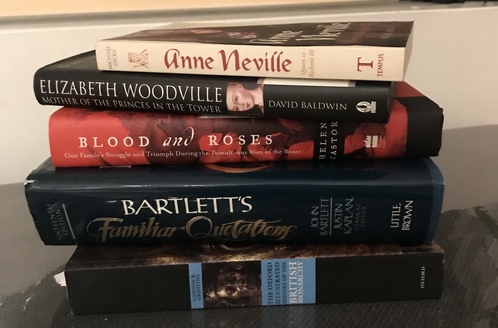
At a certain point, it’s much easier for me to find information in a hard copy of a book rather than search online.
Any Game of Thrones viewer who watched the Battle of Winterfell episode should be able to subtract the supernatural in order to envision the apocalyptic scene at the nonfictional Battle of Towton. During the battle fought by the Lancasters and Yorks on the bitterly cold Palm Sunday of 1461, both sides committed themselves to accept no surrender. In her 2004 book Blood and Roses, Helen Castor wrote:
“Both sides ordered their troops that quarter should be neither asked nor given once the battle was joined. In atrocious conditions … Englishmen fought Englishmen hand to hand for more than eight hours. The slaughter was so great that the two sides had to draw back from time to time while the heaped bodies of the dead were dragged out of their way.”
At Towton, the Yorkists ultimately gained the upper hand, and killed thousands of Lancastrians trapped on the wrong side of an icy river as they tried to flee. Others drowned. Castor wrote, “The melting snow was stained with blood, and a dark stream of clotted red was said to have snaked along the rutted roads all the way to the walls of York itself.” The blood would have been carrying good news for the family because the first Yorkist king, Edward IV, had secured his crown after years of conflict that resulted in the loss of his father, brother, and thousands of his men. For Edward, Castor wrote, Towton was “an overwhelming, awe-inspiring victory.”
Does that sound bizarrely cheerful to you, or is that just me? Writers seem to have a knack for conveying the thrill of history’s winners. I’ll wager that the Game of Thrones show runners aren’t going to let Dany feel similarly about her no-surrender, burn-them-all razing of King’s Landing. Things like that don’t happen to tough women on television shows. Real life is another story.
The nasty truth is that kindness and tolerance are high-risk characteristics for leaders in a world accustomed to rule by brutishness, whether fictional or factual. In the Game of Thrones season 5 finale, for instance, Jon Snow is labeled a traitor and stabbed to death by his own men for peacefully interacting with the loathed northern people known as wildlings. In the real 16th century, the Catholic Mary Queen of Scots tried to be generous with her rebellious Protestant subjects, saying all people could worship as they please. She lost her throne, then her head. On HBO, the temporarily dead Jon Snow was brought back to life by magic in season 6, episode, 2. The Queen of Scots had no such luck in 1587. Her situation was permanent.
Mary’s head, by the way, was forcefully parted from her body at the command of her cousin, Elizabeth I of England. Oh, how I wish Good Queen Bess could step out of one of her many fictional portrayals and into Game of Thrones to chat with Daenerys. Elizabeth I believed in the Divine Right of Kings the way Daenerys believes in her destiny. That’s par for the course for any monarch, meaning that I didn’t buy for a second the idea that GoT‘s conniving Varys had an overriding concern for ordinary people of the realm based on Daenerys’s date with destiny. Nope. The moment Varys found out that stupid, resurrected Jon Snow had a claim to the throne, the canny advisor known as “the Master of Whisperers” figured the powerful people who truly mattered to him would be more likely to swear allegiance to a male ruler, rather than a female one. (That Jon Snow said he didn’t want to rule would be a plus for any hangers-on with hustle — not because it makes Jon Snow moral, but because he’d be likely delegate more power to his advisors.) My Matilda sword necklace and earrings were inspired by the real-life version of that — an epic tale of 12th-century civil war that Game of Thrones has mirrored before.
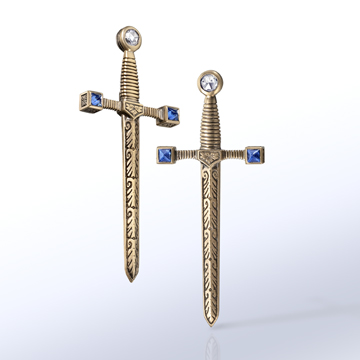
Daenerys’s execution of Varys would have received the Elizabethan stamp of approval. Daenerys also correctly identified Jon Snow as the real source of her betrayal. The question is why did she become so entangled with him in the first place? It’s one thing to spend a blissful night or two with a nonthreatening bastard son of a nonroyal house who tells ridiculous stories about the walking dead. But Elizabeth I would box Daenerys’s ears for risking her own divine person, plus her greatest treasure and main source of power — her dragons were her children! — for a mopey guy with a vivid imagination and a history of bad leadership that stands out in a world of poor military tactics.
Elizabeth I was careful about men, as you might expect, considering her father, Henry VIII, beheaded her mother, Anne Boleyn. “I will have here but one mistress and no master,” Elizabeth said, and remained “the Virgin Queen” (Is that a parallel to “Unburnt”? Maybe!). Elizabeth did have a great love — Robert Dudley, Earl of Leicester — but she refused to marry him. After Dudley died, she transferred her affections to his stepson, Robert Devereux, 2nd Earl of Essex, who was 33 years her junior. The new Robert was young, cute, and stupid. He was Jon Snow, but worse, because he was disrespectful. When Essex got sassy with Elizabeth in front of other people, she slapped him …
… and he REACHED FOR HIS SWORD. WTF? That should have been a dragon-fire death or the real-world equivalent right there, but she forgave him. He didn’t get any smarter — do they ever? — and he ultimately organized a half-assed rebellion against Elizabeth. She had him beheaded, which she was very depressed by. Her grief was terrible. She was sorry he behaved so foolishly. She wasn’t sorry for killing him. You don’t! jeopardize! royal! authority!
In contrast, Daenerys got so dickmatized that when Jon Snow asked, “Want to come up and see my ice monsters?”, she ended up financing and fighting most of the battle against the dead for him. She armed his people with dragon glass; provided her larger, superior fighting force; and, for the Battle of Winterfell, brought the most precious things of all — the two dragons she still had after losing the third and having it weaponized against WHILE SHE WAS SAVING JON SNOW AND HIS FRIENDS. This isn’t queenly! Who is working for whom here? If I weren’t so sure that Jon Snow knows nothing …
… I might believe he was crazy like a fox when he told Daenerys that he was the rightful heir to the throne minutes before they had to fight thousands of living skeletons. She couldn’t kill him right then and there in his own house. She was still in love. Also, people would have noticed. Someone like Cersei — who was selfish but strategic in staying out of this fight — might have had the presence of mind to take him out by friendly dragon-fire during the battle. Hindsight being 20/20, Jon Snow wasn’t the key to victory.
But the final nail in Jon Snow’s second coffin should have been the moment he swore fealty to Daenerys as his queen and then went off, against Daenerys’s express wishes, to tell his sisters that he was the true heir. In a real-world history book, this interaction would be found in the index under “treason, Jon Snow’s.” It’s literally the definition of the word. Or maybe it would be under the listing “mirth or japes” because, as Daenerys pointed out, Jon’s claim rested on the testimony of his brother with the thousand-yard stare, and his studious best friend. Laughable, until he tells people who are prepared to use it to their advantage. Remember Mary Queen of Scots? She had a blood claim to the English throne, and when she fled Scotland, she thought her generous cousin Elizabeth I would take her in. Elizabeth, knowing a threat when she saw one, wisely imprisoned Mary for close to two decades and still, wannabe usurpers whispered about putting Mary on the throne. Elizabeth’s advisers felt their queen was nurturing a serpent in her bosom. In fact, they called Mary “the bosom serpent.” That’s why Mary lost her head, and why I named a snake necklace (and matching ring, earrings, and tiara) named for her.
As we head into this Sunday’s Game of Thrones series finale, Daenerys has lost her most trusted companions, Jorah Mormont and Missandei, to death. Her advisor Varys turned on her as soon as a male rival was in the offing, and her other advisor Tyrian should have suffered the same fate for giving Varys the power of knowledge. I don’t know what the show runners have in store. Will their evil, insane Dany — who is the same person as my merciless but smartened-up Dany — be assassinated in the midst of her dragon-advantaged fighting force? Who will do it? Arya — a killing machine — lost her series-long thirst for vengeance and crumpled like a child in a few moments that were as shocking to me as the burning of King’s Landing was to other viewers. Will Jon Snow, who always thinks he’s doing terrible things for noble reasons, take it upon himself and become a well-meaning but weak king? Sansa is one of the few characters who was allowed by the show runners to retain her hard-won intelligence, unlike Tyrion. I don’t have the answer.
The only answer I have is for the question of “Why do I watch this stupid fucking show?” It’s because I love Peter Dinklage and I love dragons, my friends. I’ve loved Peter Dinklage since The Station Agent in 2003 (and I got to meet him once!). I’ve loved dragons forever. When I was a kid, I was obsessed with the Dragonriders of Pern book series by Anne McCaffrey. When a jewelry-industry magazine did an interview with me in 2013, I was talking about a dragon-shaped bell I had in the 1980s, and how it inspires me to this day.
When Game of Thrones premiered eight years ago, there was no way I was skipping a Dinklage-and-dragons show. Then I became invested in other characters and then, ever the optimist, I couldn’t stop hoping for a fantastically told story. Alas, GoT seems poised to be an artistic letdown. Fortunately, I’ve still got ample optimism for powerful women in the real world, where it matters. My dream is to finish the last and largest Maneater design in time for our next president to wear it to her Inaugural Ball.
